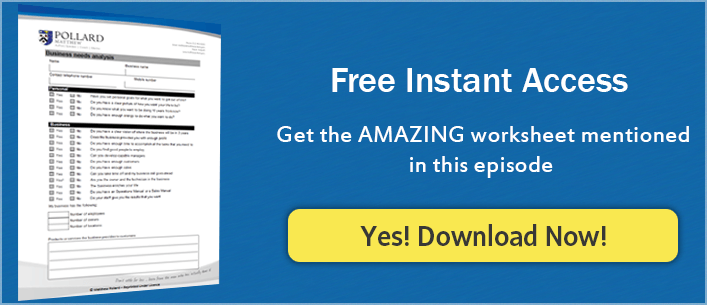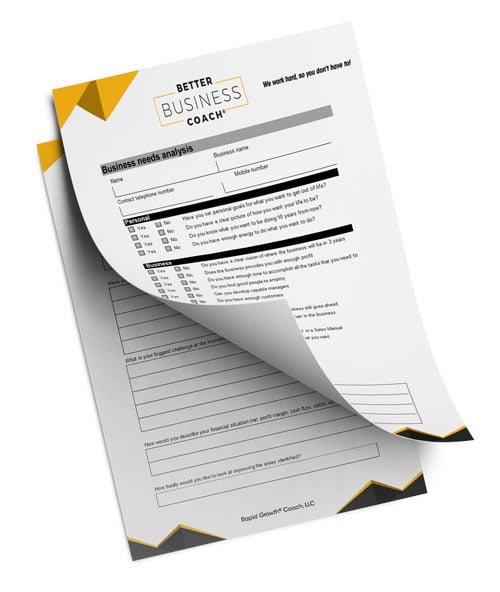Better Business Coach Transcript
This is Better Business Coach, session number 21.
This is The Better Business Coach Podcast, your source for critical sales training, proven education and actionable worksheets – all downloadable for immediate use. We work hard so you don’t have to. Now your host, the rapid growth guy himself, Matthew Pollard.
Hello everyone and welcome back to The Better Business Coach. My name is Matthew Pollard and as always I am your Rapid Growth Guy. Today we’re going to be discussing force field analysis, and this form is vital, especially for the much, much smaller businesses.
See the SWOT Analysis is fantastic for helping people see the strengths, the weaknesses, the opportunities, and the threats of a business. However, what do you do from that point. And the honest answer is that when you see a weakness you want to be able to fix that. So when you’re trying to fix a weakness you want to be able to look at what’s going to help us fix that weakness and what’s going to stop us fixing that weakness. And the same with a strength. If you’re looking at a synergy between a strength and an opportunity, you want to look at what’s going to help us achieve that synergy and get that out to the marketplace, and what’s going to stop us doing that. And that’s what the force field Analysis does.
So let’s get straight into it, I’ll pull it up on the screen now. So this is the force field analysis. Now if you’re listening to this rather than watching it, it is a video podcast, so you can go back at a later date if you’d like and type in “better business coach podcast” and watch the video version on iTunes, it’s session 21, or go to betterbusinesscoachpodcast.com and there you’ll be able to access session 21. Click on the “read more” under that session and you’ll be able to watch the video there. You’ll also be able to watch it on YouTube. If you haven’t connected with me through that yet, type in “better business coach podcast” and you’ll get access to all these videos through YouTube as well if you prefer that.
Now the force field analysis is used in a couple of different ways. Firstly it’s used for clients that you feel that the SWOT analysis may be a little bit too overcomplicated for them. And you may choose to just grab out of the where is your business now, what’s your greatest challenge, and talk about what improvements and do a little bit of brainstorming about what desired changes are required and write that down, and then you can use this form.
For people that are transitioning from the SWOT analysis, you can skip this step. I prefer not to, I prefer to talk about what was covered in session 20. And again, if you haven’t listened to session 20, a lot of this won’t be making any sense to you. So go back and listen to that session.
However, we just covered off on strengths, weakness, opportunities, and threats of a business. We also talked about – based on each one of those – to create five columns. And in the left hand column to write all your strengths, weakness, opportunities, and threats.
In the second column, write the implications of those certain strengths, weaknesses, opportunities, and threats, and also all the synergies that you can see between your strengths and opportunities that are coming out in the market.
Then in column three you write the indicated actions of that. Column four you write the resource allocation requirement. And then in column five you write down what the opportunity cost of not taking that action is, ie: lost business, going broke, potential loss in additional sales, and also the opportunity cost of what it’s actually going to physically cost you to implement a change or improvement as opposed to doing something else like investing that money into something else that will give you another benefit.
Now this form works very much in line with that because each one of the indicated actions will have an improvement requirement or desired change that’s going to be necessary. And you’ll be able to use this form to make sure that you can highlight what will help you get there and what will stop you getting there.
So let’s scroll down and I’ll give you a few examples. So a good example of this would be let’s say you want to implement a CRM system. A CRM system in a business can obviously do drastic things for helping with customer management, so what will help you get there You might have a staff member that is very into technology and knows all of the CRM systems. You yourself may be very technologically advanced and know all the CRM software, so they may write you down as their coach that understands all the CRMs and will be able to help them integrate the system.
What will stop them getting there? They may write down that the staff have issues with technology. Maybe there are a lot of older staff or younger staff that haven’t embraced technology, and as a result, if they implement a CRM system there’s going to be lots of barriers there. And what we’re really highlighting perhaps, is that throughout the coaching process we need to unfreeze these staff members to the fact there’s going to be change and that it’s required. Get them on board with the change before we implement it and then refreeze.
Now if you haven’t listened to the session on change management – which is session 12 – I’d suggest if that specific thing is going to stop you getting there comes up, then you should listen to that session before you go out and work with a client. You’ll be able to see it’s highlighting specific sessions you need to have with the client.
Another thing that could be a desired change or improvement is the fact that they decide perhaps that they want a unique message because they’re currently competing on price and they decide that that’s something that’s got to change. Because competing on the price, which everybody knows if you compete on price it’s going to be a long race to the bottom, and that’s the last thing we want to do.
So we may decide for our indicated action from the SWOT analysis that our goal is that we need to create a unified message that’s going to differentiate us from our competitors. What’s going to help us get there? We may have a load strengths that are different than our competitors and we can capitalize on those strengths, so we write those down. What’s going to stop us getting there? Well we may decide that we don’t have time, so perhaps what we’re really highlighting here is that we need to focus on time management first.
So the whole idea of this form is really just to talk about and highlight what’s going to help you fix certain problems, and what’s going to stop you from fixing certain problems and implementing desired improvements. It’s a very basic form, as I said in the last episode, so this session was going to be very short. However, the important thing to recognize is that it’s just a stepping stone process from the SWOT analysis and from doing the five columns that we discussed in the last session, and gave you the basis of in this session as well. And as I said earlier, this worksheet as well is downloadable for you to utilize with your clients at matthewpollard.guru/bbc021. This is going to be the shortest one of the templates we do, however it’s still vitally important and it’s a great follow on from the SWOT analysis.
Ok everyone, I hope you got value out of the force field analysis and I hope you can see how great this works for small businesses especially. Now again this is downloadable so make sure you go to the link that I mentioned earlier and download it from my website so you can start using this for your clients straight away.
Again, we really do value your reviews, so if you haven’t already please hop on betterbusinesscoachpodcast.com, click on the iTunes link and post your review with a 4 or 5 star rating, it would be very, very appreciated. Alternatively, if you’re on an iPhone app, just type in “better business coach podcast” and post your 4 or 5 star review there. I would really appreciate it and I look forward to seeing you in the next episode of Better Business Coach Podcast. Thank you.



























